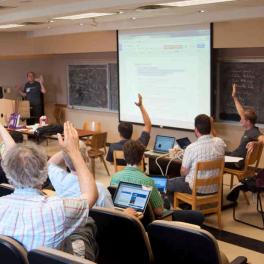
Over the past several decades, the internet has substantially improved people's access to information. At the turn of the millennium, this spirit of access prompted the so-called open educational resources movement, which advocates for digital instruction materials to be accessible for free around the world. By the early 2010s, massive open online courses (or MOOCs) emerged as a popular way to learn new things, and Associate Professor Jim Fowler and Assistant Professor Bart Snapp represented the Ohio State Department of Mathematics in this exciting new direction in education.
With support from the National Science Foundation, Fowler and Snapp designed an interactive textbook platform called Ximera. A mathematician might recognize “X” as the capital Greek letter “chi” (pronounced like a “K” in English), which mimics the “X” in the standard mathematical typesetting language LaTeX. Ximera enables math instructors to convert easy-to-write LaTeX documents into interactive online activities for their students.
You can see for yourself what Ximera is like by visiting ximera.osu.edu and clicking "Experience Calculus One" to peruse a free calculus course. There, you will be immersed in the sort of definitions, theorems and figures you might find in a traditional textbook, but you'll also encounter interactive questions, examples and explanations that are designed to help a student learn that information. Ximera makes it easy to play with the material and test your understanding at your own pace. This presents a compelling, scalable alternative to personalized instruction.
The data suggests that Ximera is a hit. Ximera regularly sees tens of thousands of visitors in a single day, receiving more than 700,000 visitors in 2021 alone. In addition, all the code in the backend of Ximera is available for free on GitHub for interested parties to revise, remix and redistribute as desired. In this way, Ximera is truly an open educational resource.
